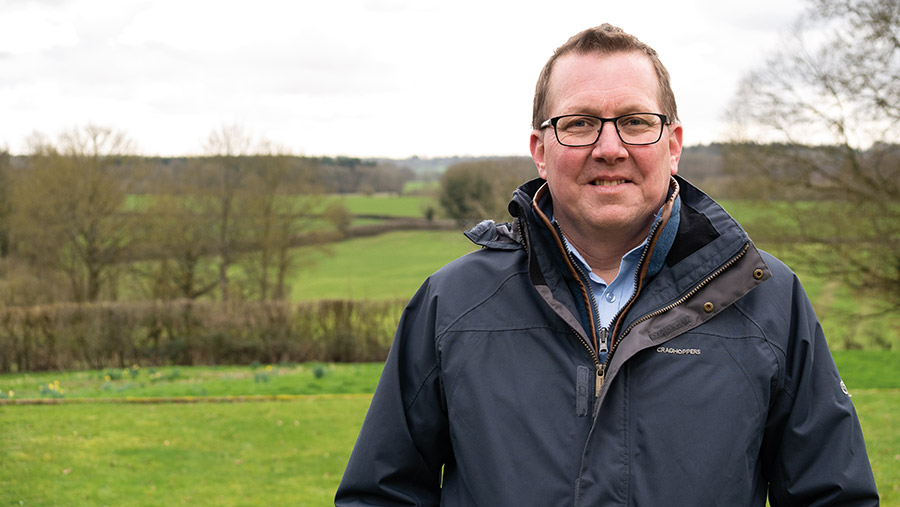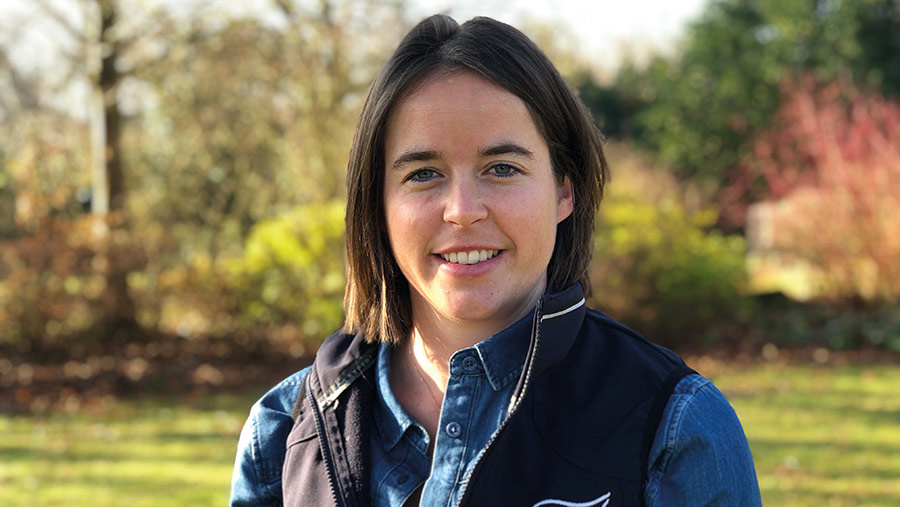Agroforestry and direct sales in plans for carbon negative farm
 Andy Bason @Leaf
Andy Bason @Leaf Reducing carbon emissions is a key goal for Hampshire farm manager and Transition Farmer Andy Bason, who says doing so will improve profitability as well as benefiting the environment.
Mr Bason has devised a series of short-, medium- and long-term targets as he strives to develop a truly sustainable farm business – including 600ha of combinable crops at Newhouse Farm, Northington Down, Alresford.
While flexibility is vital and some timescales may slip, Mr Bason says he is determined to achieve the goals, drawn up under the Resilient and Ready programme delivered by Linking the Environment and Farming (Leaf) and Corteva.
See also: Securing a sustainable future – where should farmers start?
The three-year programme offers training, technical support and mentoring for farmers to become more sustainable, build the resilience of their own businesses and gain the skills, confidence and know-how needed to be industry innovators.
Farm facts
- 800ha main farm
- 600ha cropped
- 70ha woodland
- 40ha overwinter stubble
- Winter wheat, spring barley, spring beans, oats, linseed and oilseed rape
- Cover crops before spring crops
- New contract farming agreement of neighbouring 400ha
Transition goals
- 30% cut in carbon emissions
- Establish 10ha of agroforestry
- Establish 10ha of woodland
First-year goal
The immediate priority is a 30% reduction in carbon emissions, coupled with an increase in the “active carbon” component of the farm’s soil, so nutrient cycling works well.
Following the advice of Ian Robertson of Sustainable Soil Management, Mr Bason has already seen soil organic-matter levels rise to more than 6% in some fields by making small incremental changes, and he is hoping to hit a 2% active carbon level. That figure currently stands at 1.48%.
“We haven’t done anything radical,” he explains. “All the crop residues get chopped and put back on the soil, and we’ve used cover copping for the past five years or so.”
Materials such as sewage sludge and compost aren’t used as soil improvers, with Mr Bason preferring to keep the operation in-house and avoid any contamination.
A soil management policy ensures that the team sticks to the 30m tramlines and avoids travelling when wet, while cover crops help to maintain soil structure.
Fertiliser use has come down by 18% over 10 years, thanks to rotational changes, soil health gains and small deductions in applications.
Fuel use has fallen by 40%, from 82 litres/ha to 50 litres/ha.
With these changes and the presence of 70ha of woodlands, the farm is already carbon negative.
Having done a carbon footprinting exercise with the Farm Carbon Toolkit, Andy is now looking to keep it this way and make further strides, rather than sell carbon credits.
Newhouse Farm switched to min-till in 2000 and is now “pushing towards no-till”, only using cultivations strategically. Cover crop mixes of oats, linseed and phacelia are grown, before being rolled flat in January in a frost.
“We need to get the biomass knocked down early,” he says. “Then we use glyphosate just ahead of drilling.”
10-year goal
His medium-term goals are to introduce agroforestry to a 10ha block of cropped land, which, with the help of some wildflowers, will boost beneficial insect numbers and reduce the use of pesticides.
He also intends to try and sell 30% of the farm’s produce direct to consumers.
“We already have direct sales of pork and lamb from the farm and have started to sell flour to local mills,” he reveals. “There is good demand and plenty of interest in what we are doing.”
The trees will be planted this autumn and will predominantly be apple trees, with the possibility of some walnut and pear trees, too. With eight 4m strips across the block, there will 300 trees in total.
Mr Bason’s plan is to produce Newhouse Farm apple juice, which could go out with the pork and lamb boxes.
He also hopes that he will be able to set up and launch a community project, letting locals come and pick apples and enjoy the resource.
He attended an agroforestry course, so is aware of the ongoing tree maintenance commitment once they are established.
“We have already established a plum orchard so we know what’s involved.”
Having investigated possible funding sources, the business is footing the bill for the trees at about £5,500 and the farm team will plant them.
Wildflowers will also be planted in the strips, so that insect numbers go up and insecticides can be eliminated.
“Our pesticide use is coming down all the time,” he comments. “This will help take it even further.”
30-year goal
Longer term, the business is developing a 10ha wood, with the aim of leaving a legacy of carbon capture and a place for wildlife.
Land-use change can be a difficult subject, acknowledges Mr Bason. But farm owner Ian Cammack has been keen to press ahead and a suitable site has been identified.
Three less-productive fields will be used for the project, so it has already produced its last combinable crop.
With plenty of deciduous woodlands around, Mr Bason received help from Kirsty Brannan, farm conservation and woodland adviser at seed supplier Oakbank, to decide where conservation efforts would make the most difference.
As a result, he will also be planting new hedges and linking up woodlands, providing more habitat and increasing the amount of carbon capture in woody biomass.
Creating the new wood will involve planting 20,000 trees – 80% will be native species and 20% non-native. To encourage wildlife, there will be a pond in the middle and some rides and glades established.
High deer pressure means that it will have to be fenced, reveals Mr Bason. “We’ve also had to look carefully at making sure that it will be climate-proof by selecting the right species and the right mix.”
Funding for the new wood has been secured from the Forestry Commission’s Woodland Creation Planning Grant.
Mr Bason accepts that taking land out of production isn’t right for every business, especially where it is likely to span generations.
A new contract farming agreement with a neighbour has recently added 400ha to his responsibilities, so productive arable farming is still very much on his agenda.
“We’ve looked at nature-based solutions as we know that we have to adapt and change to survive,” he concludes. “I’ve had help to cut through some of the noise and am now in a position to do some of the things that should work here and allow us to deliver public goods.”
Progress to date
- 18% reduction in fertiliser
- 40% reduction in fuel
- 10ha of agroforestry this autumn
- Site earmarked for 10ha wood
Alice Midmer, demonstration and innovation manager at Leaf, reveals that the organisation will be celebrating its 30-year anniversary this year, so seeing what Newhouse Farm might look like in another 30 years is an interesting exercise.
“If you ask farmers how they want to leave their land, the answer is usually that they want it to be in a better state.
“By focusing on Mr Bason’s one-, 10- and 30-year goals, together we’ve come up with an ambitious plan that works for soils, air, water, biodiversity and the wider landscape, while still producing safe and nutritious food.”

Alice Midmer © Leaf
Andy Bason is one of our Transition Farmers. Join them as they strive to become financially and environmentally sustainable and how they intend to overcome the challenges they face over the next five years.
